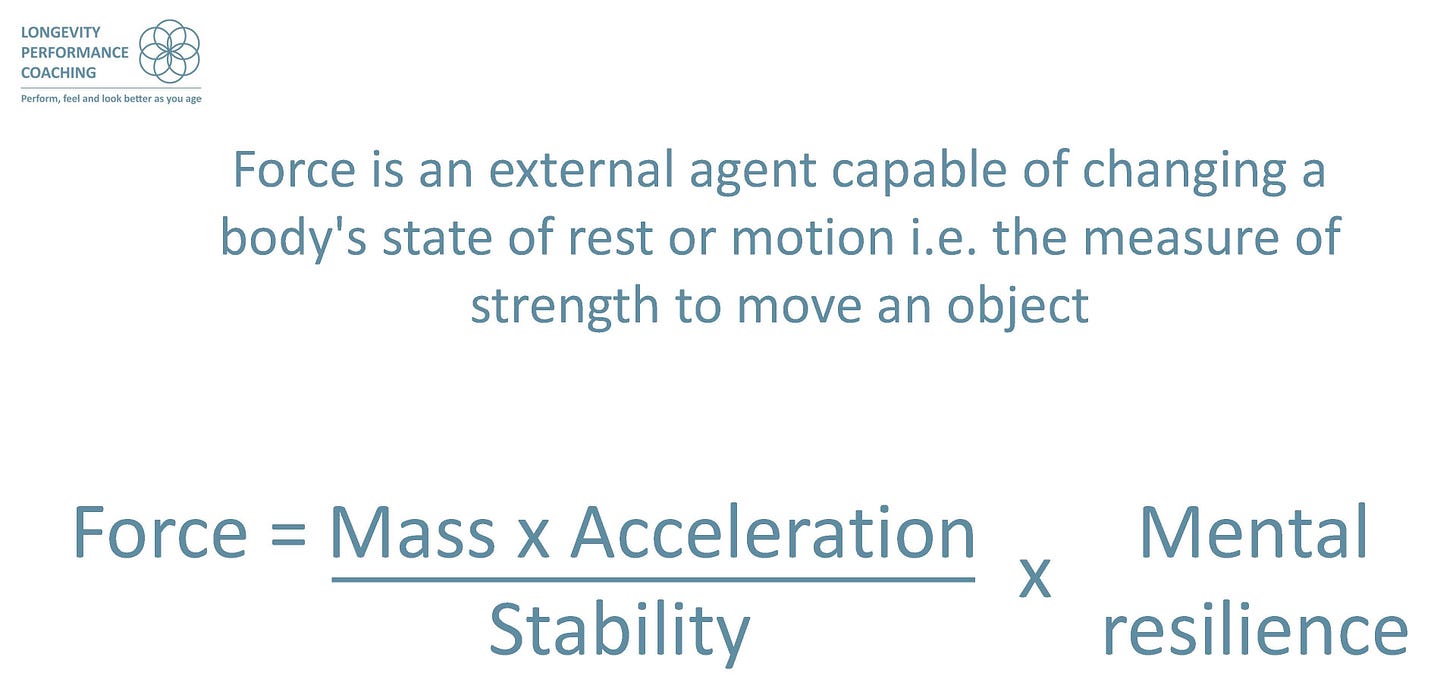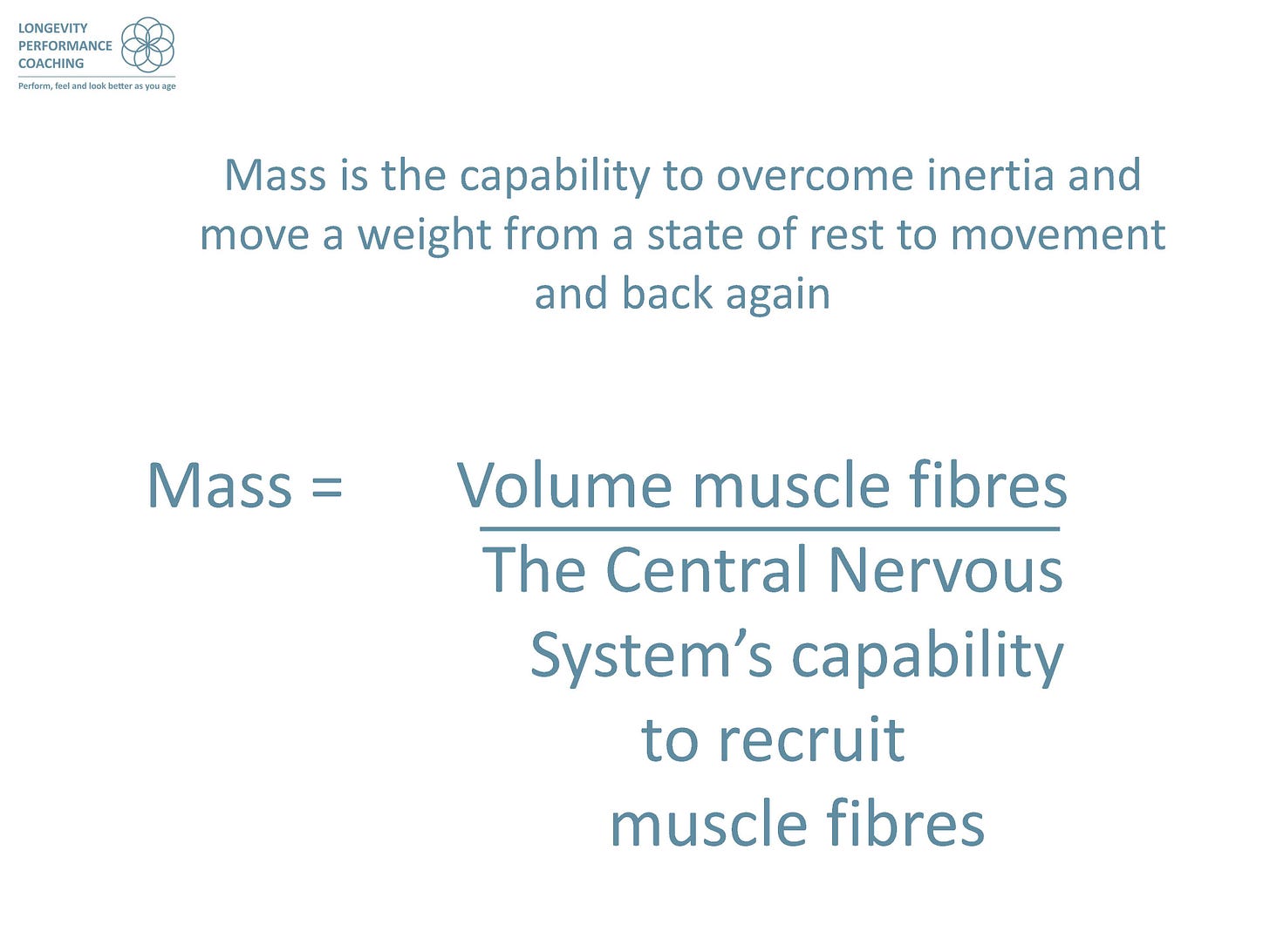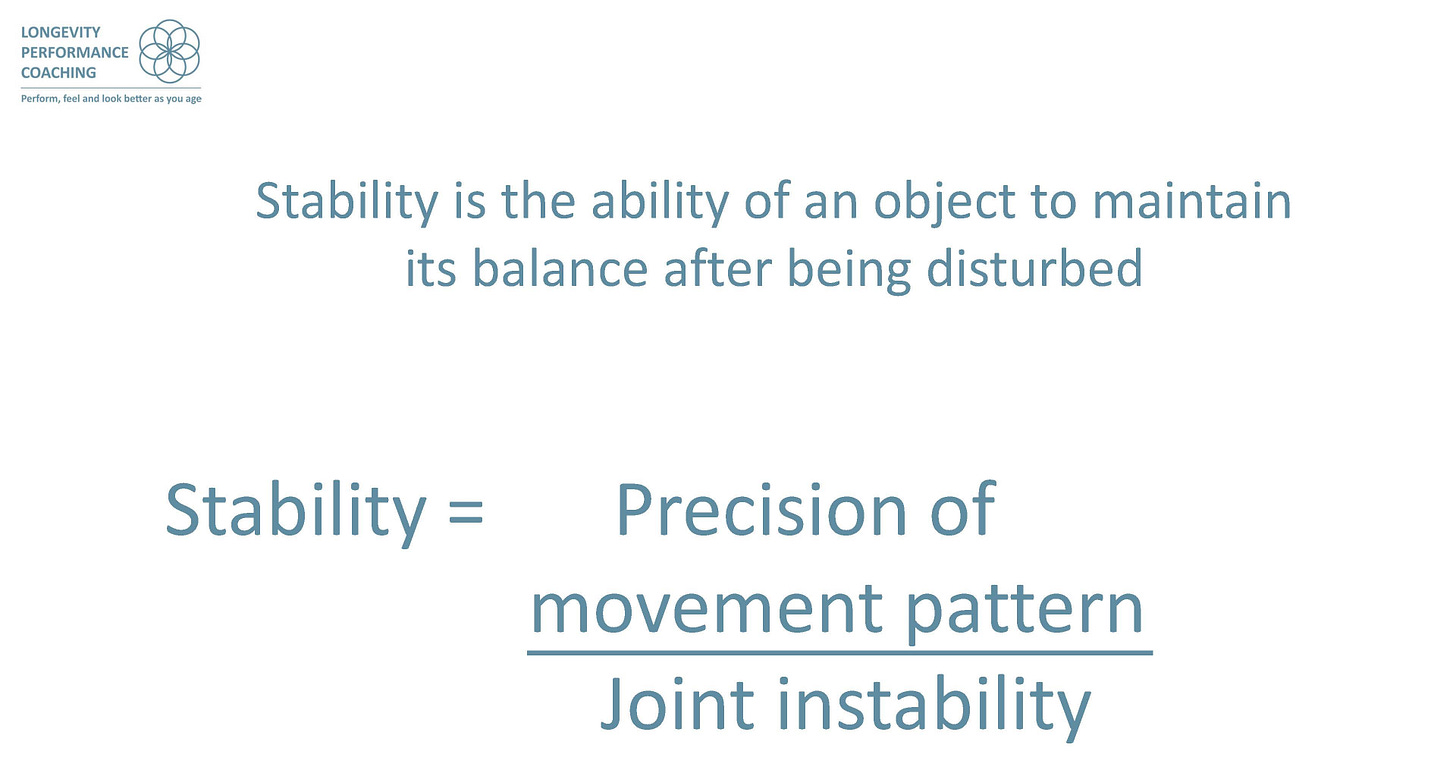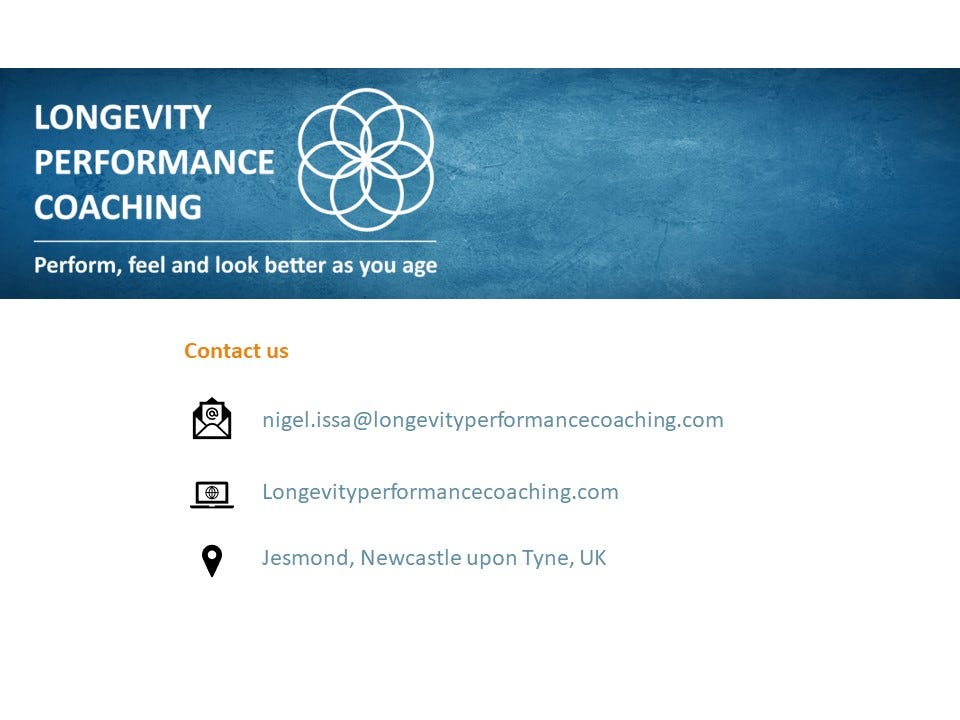This post follows on from post #13 where I outline why strength is an important capability for performance and longevity.
In this post I’m going to bring together the components of how you build strength. If you thought resistance and strength training was for meat heads, I’m about to show you the complex formula you have to master to become and remain strong.
What is strength?
Strength is about how we exert force to move ourselves and objects around us but also control and stop the movement as well. I’m not going to cover benchmarks of strength in this post, that will be covered in one in the future.
Note there are two limiting factors to strength, stability and mental resilience. This is the reason why most people find getting strong difficult. I will cover these later.
The more force you can generate the stronger you will be so lets first understand the element that everyone focuses on when they think strength training.
Mass moves mass
If you go to a gym you will see lots of predominately men, with large muscles. Your obvious reaction will be they must be strong. But that isn’t generally the case. If they are focused on body building then the muscles are for size and definition not to generate force.
Mass has two elements, yes you have to have muscles but how you recruit and coordinate them dictates how useful they are in being strong.
To be strong there is an element of building muscle but just as important is the training of the central nervous system to recruit and utilise muscle.
The saying mass moves mass is true but it works like this.
If you have 100kg of muscle but only recruit 50% that means you have access to 50kg. If you have 60kg of muscle, but can recruit 90% then you have access to 54kg, so you can probably exert more force and be stronger.
This means the mass part of this equation needs two types of training.
Hypertrophy training to build muscle with sets of resistance training, typically in the 10 - 30 rep range, 60-80% of the maximum weight you can lift. Plus quality nutrition to build muscle. You can find lots of content on this, the best and most sensible advice is Renaissance Periodization fronted by Dr Mike Israetel.
Central nervous system (CNS) training which requires you to lift heavy weights between 80-95% of the maximum weight you can lift for 1-3 reps
We are always fighting gravity
Mass enables you to move yourself or an object, but gravity quickly kicks in to pull you or the object to the centre of the earth!
To be strong we have to be able to beat and fight gravity. This is where acceleration comes in.
What this means for being strong is that not only do you have to recruit muscle fibres but they have to contract fast enough to beat gravity and they also need endurance to sustain that force until the movement is complete.
Try holding your arms out in front of you and see how long you can hold them before they tire. Now take a small weight and do the same. You can hold this for a lot less time. Then take a larger weight and you may be able to lift it from the ground but may not be able to hold it in front of you at all or for very long. This progression in weight demonstrates the need for endurance and at the last stage, explosive strength to get the weight to shoulder height.
To improve acceleration you need to develop type 2, fast switch muscle fibres that can generate a lot of force quickly. Plus you need to develop a lot of them to generate the muscle endurance capability to beat gravity throughout the movement.
The training for acceleration is speed training where you use between 40-75% of the maximum weight you can lift and do 3 reps every 30 seconds for 8 -16 sets. This enables you to focus on moving the weight fast but the limited rest period means you have to recruit and develop more and more type 2 muscle fibres to complete the sets.
It’s the little muscles you can’t see that count
Now we move on to the main limiting factors, the first being stability.
Instability in the body leads to two consequences.
Mass and acceleration leakage as the force can’t be exerted in the direction it needs to be.
Injury as the leakage is dissipated through the muscles, joints, tendons and ligaments of the body. If the leakage of force is too great something in the body gets worn out or breaks resulting in injury.
Strength training has an unfounded perception that it is dangerous. The reality is it is much safer than most other exercise modalities, but only if you have good stability. Without good stability you will get injured.
If you want to get stronger you don’t start with mass or acceleration you start with stability.
This means from your foot to your head, the ability to move with precise and efficient movement patterns combined with the development of stabilisation muscles around the joints (including the back vertebrae joints). To reduce instability as much as possible.
A good strength training programme should start with 6 weeks of foundational movement pattern training focused on how to:
Squat
Hip hinge
Press in front and above your head
Pull in front and above your head
Plus work to build stabilisation muscles in the:
Upper, middle and lower back
Shoulders
Hips
Knees
Ankles and feet
Stabilisation is the non negotiable activity you should do for the rest of your life as the more stable you are the more you can move. This isn’t going to make you look like you have big defined muscles as most stabiliser muscles sit deep in the body and are type 1 high endurance muscle fibres so you can’t see them. But you will know about them when they get injured, so build and maintain them and your joints will repay you with years of pain free movement.
Read post #12 for exercise ideas to improve stabilisation Click here to read post.
No pain no gain?
When you go in gyms they often have motivational wall graphics such as:
“No pain no gain”
“The pain you feel today is the strength you feel tomorrow”
“Your body can do it, it’s time to convince your mind”
Feel inspired reading these quotes? Probably not as there are two problems with them.
You had to have turned up to the gym to read them so you are already motivated
Pain generates fear not motivation
To be strong you need resilience. The more of it you have the faster you will get strong and maintain it. Without resilience it becomes a limiting factor to getting strong.
All the other elements discussed so far have one common theme. They all aim to stress the body so that it adapts to generate mass, acceleration or stability.
Resilience as the definition says is your ability to adapt to that stress both before, during and after you train. Without resilience you will not have the motivation to train and recover at the intensity required and you will talk yourself out of training which creates inconsistency that causes strength to decline.
Motivation is a very personal driver, which you must have clearly defined in your mind before embarking on your strength building journey. In my experience motivation gravitates around three goals.
How I want to look. Women aspire to be toned, men aspire to be muscular. You may not want to admit it but when you look in the mirror everyone wants it.
How I want to feel. This is both in terms of general health especially with stability training, joints and muscles don’t hurt any more. It is also about building confidence to do your job better, complete every day tasks easily and continue to do activities you love for as long as you want. This is a very strong motivational driver and should be a key goal to get clear before you start.
How I want to perform. This can be more of an external driver. Some people use challenges or competitions that require strength to drive motivation. Some get obsessed with the amount of weight they can lift. Some use it as a complementary capability to help them run or cycle better.
Consistency is the hard one. Unless you are like me who spends all day in gyms, your job, social and family life create conflicts of priorities.
Like anything to do with health it is a relentless activity of daily tasks and routines to keep feeding the body. Maintaining strength is no different. Muscle and strength declines in about 25-35 days of inactivity. Therefore regular consistent training is required.
The medical guidelines are to do at lest two resistance sessions a week complemented with 4-5 flexibility and stability sessions.
If you want to get strong you have to make this type of time commitment part of your daily and weekly routine.
The most time efficient option is to have equipment at home or have a gym membership within 15 minutes of your home. The market for home gyms has exploded in the last 5 years and there are now electronic resistance devices that can be set to do the mass and acceleration training protocols discussed earlier. Check out Tonal, Vitruvian and Voltra 1 that can all be set up at home without needing any weights in the house. Or you can go the traditional way and invest in weights.
What would a strength programme look like?
If you are new to this you have to think of this as a long term commitment. From being a novice it will take about 18 months to get strong and from there you can maintain it.
A beginners programme looks like this.
Block 1 - 3 weeks foundation stability
Block 2 - 3 weeks foundation stability plus movement pattern training with light weights
At this stage there are some tried and tested approaches. I believe the best one is Starting Strength. You can Google it to find out the detail. In summary it is based around big compound lifts with a barbell - squat, bench press, deadlift, over head press and row. The aim is to add a little bit of weight each session until you can’t maintain excellent movement pattern and form. The rep range is 3 sets of 5 reps which really focuses on the mass and stability parts of the force equation.
Block 3 - Starting strength which will be about 26 weeks.
You will now be stronger than most people your age and weight and will want to maintain and even increase it over time.
My favourite and most time efficient programme for this is 5/3/1. Again Google it for the detail. This works on a 4 week cycle, again using the compond barbell movements like Starting Strength . First week you lift a weight for at least 5 reps, second week a slightly heavier weight at least 3 reps and the third week a heavier weight again for at least 1 rep. Week 4 is a deload week where you get a rest.
The programme attempt to routinely hit the mass and acceleration rep ranges and slowly build more strength as you repeat this on monthly cycles. It includes some supplementary sets to increase the volume to build and maintain muscle mass.
Block 4 - 5/3/1 for 8 cycles lasting 32 weeks.
So in total this covers 1 year and 12 weeks if you did this continuously. In reality you will go on vacation, have some weeks you are ill or travelling for work which will take you closer to 18 months.
From there you can start maintenance programmes that focus on each element of the force equation to keep things interesting and challenging.
Inspired or Put Off?
If you have read to this point you may be either inspired or it all looks too complicated. Either way there are huge benefits to building and maintaining strength as you age.
In a recent study of people who continued resistance training into their 70s their was a 47% reduction in their all cause mortality.
Strength is the human capability that exists the longest as you age so what ever age or experience level you are you can effectively build strength.
To be strong and maintain it you do need to master all elements of the force equation. My advice is accelerate your mastery and to help build your resilience invest in a coach or Personal Trainer who specialises in strength building.
Be careful who you pick as many are not focused in this area, so do your research and look for someone qualified and practicing with strength and conditioning qualifications.
Once you have selected the right person and you start your strength journey you will see your strength improve very quickly.
As Mark Rippetoe the founder of Starting Strength says “You will be surprised at what you can do”.










